Fashion Retailing Report: Marks & Spencer, Next PLC
VerifiedAdded on 2020/01/07
|12
|3817
|163
Report
AI Summary
This report provides a detailed analysis of two leading fashion retailers, Marks and Spencer and Next PLC, focusing on their target markets, adopted policies, and the influence of market characteristics on their strategies. It examines the impact of fashion trends, including the influence of celebrities, media, and climate, on consumer behavior. The report also compares niche and mass markets, evaluates the companies' brand images, and identifies weaknesses and gaps in their operations. The conclusion highlights the importance of aligning with market conditions and maintaining a positive brand image for long-term success in the competitive fashion industry.
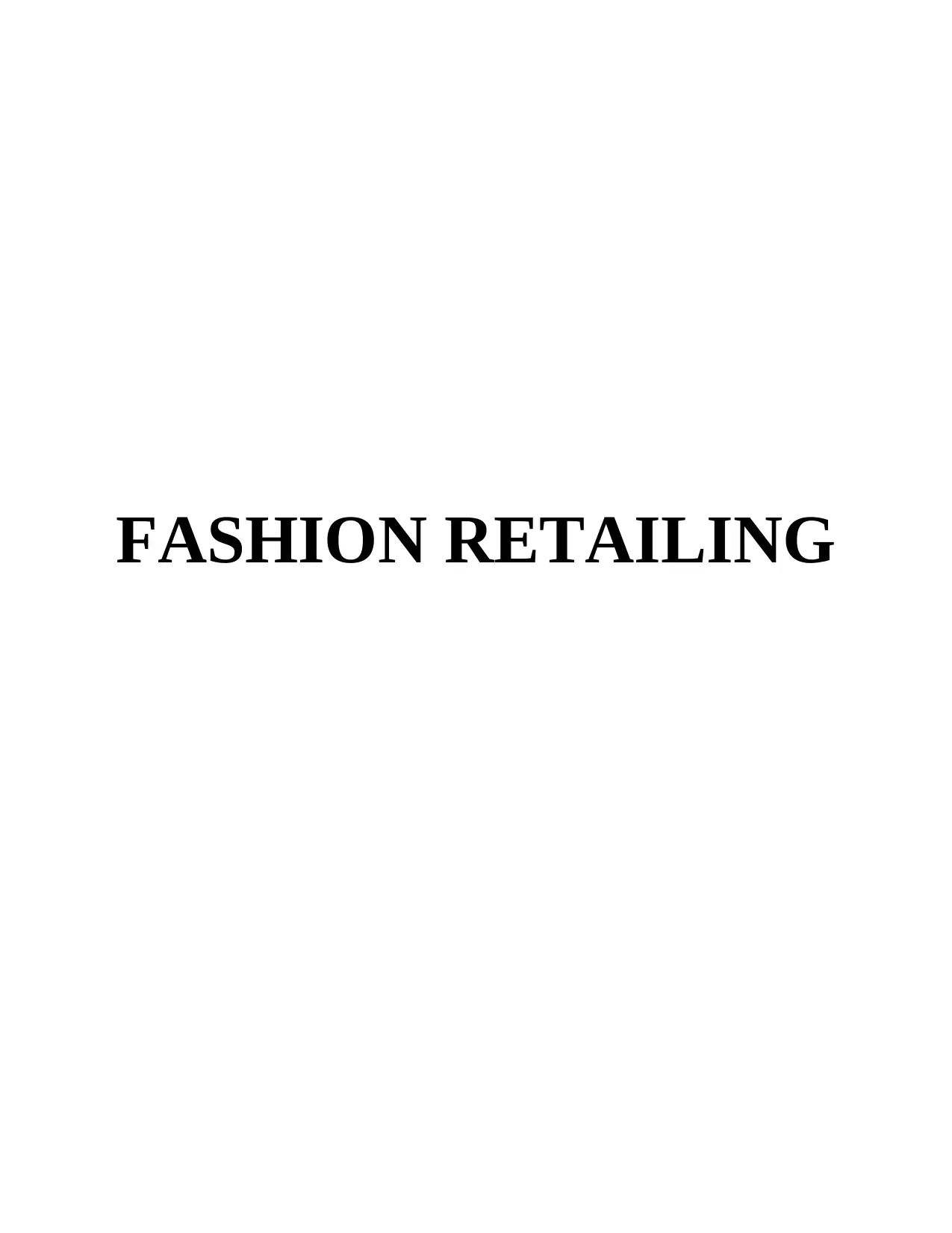
FASHION RETAILING
Paraphrase This Document
Need a fresh take? Get an instant paraphrase of this document with our AI Paraphraser

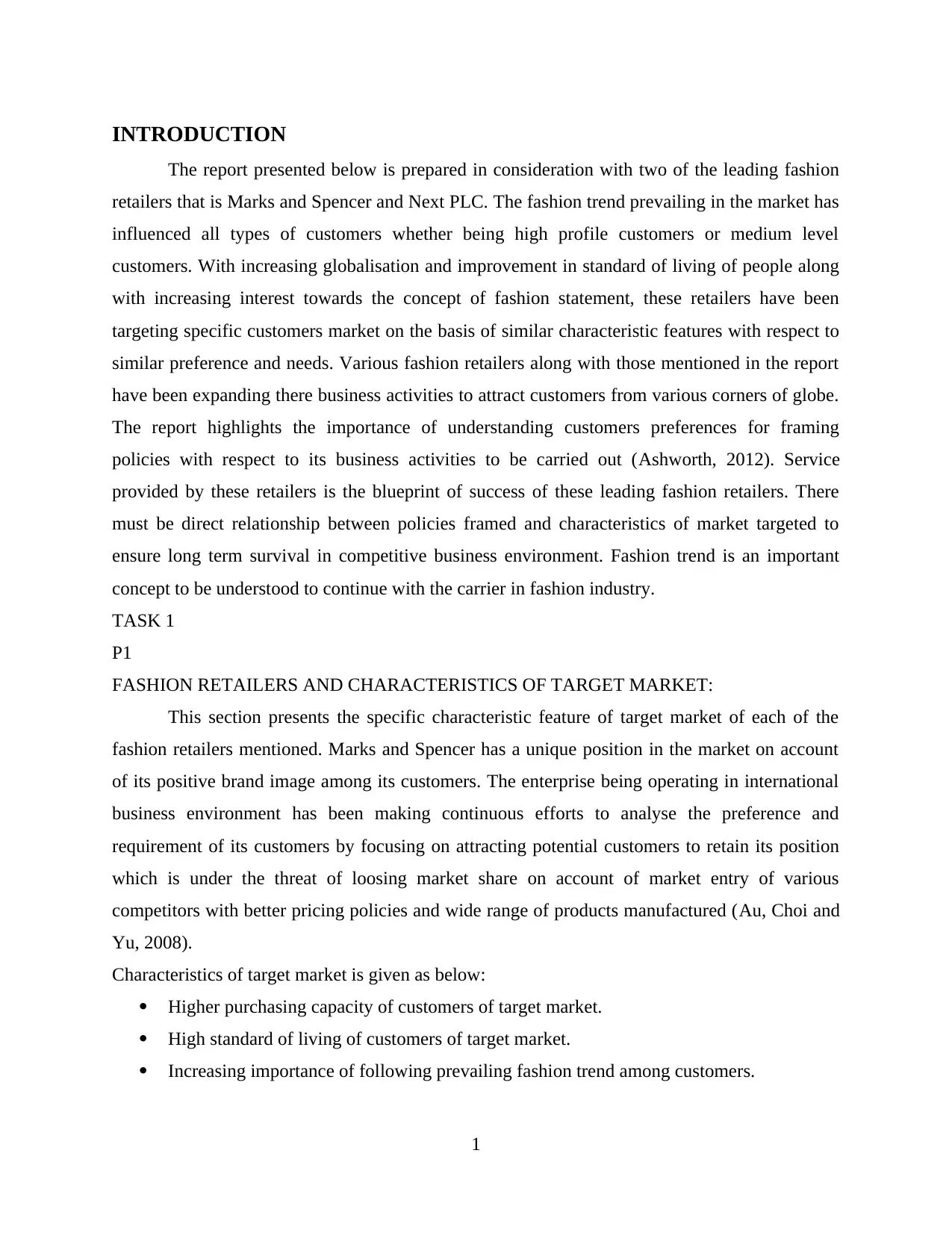
INTRODUCTION
The report presented below is prepared in consideration with two of the leading fashion
retailers that is Marks and Spencer and Next PLC. The fashion trend prevailing in the market has
influenced all types of customers whether being high profile customers or medium level
customers. With increasing globalisation and improvement in standard of living of people along
with increasing interest towards the concept of fashion statement, these retailers have been
targeting specific customers market on the basis of similar characteristic features with respect to
similar preference and needs. Various fashion retailers along with those mentioned in the report
have been expanding there business activities to attract customers from various corners of globe.
The report highlights the importance of understanding customers preferences for framing
policies with respect to its business activities to be carried out (Ashworth, 2012). Service
provided by these retailers is the blueprint of success of these leading fashion retailers. There
must be direct relationship between policies framed and characteristics of market targeted to
ensure long term survival in competitive business environment. Fashion trend is an important
concept to be understood to continue with the carrier in fashion industry.
TASK 1
P1
FASHION RETAILERS AND CHARACTERISTICS OF TARGET MARKET:
This section presents the specific characteristic feature of target market of each of the
fashion retailers mentioned. Marks and Spencer has a unique position in the market on account
of its positive brand image among its customers. The enterprise being operating in international
business environment has been making continuous efforts to analyse the preference and
requirement of its customers by focusing on attracting potential customers to retain its position
which is under the threat of loosing market share on account of market entry of various
competitors with better pricing policies and wide range of products manufactured (Au, Choi and
Yu, 2008).
Characteristics of target market is given as below:
Higher purchasing capacity of customers of target market.
High standard of living of customers of target market.
Increasing importance of following prevailing fashion trend among customers.
1
The report presented below is prepared in consideration with two of the leading fashion
retailers that is Marks and Spencer and Next PLC. The fashion trend prevailing in the market has
influenced all types of customers whether being high profile customers or medium level
customers. With increasing globalisation and improvement in standard of living of people along
with increasing interest towards the concept of fashion statement, these retailers have been
targeting specific customers market on the basis of similar characteristic features with respect to
similar preference and needs. Various fashion retailers along with those mentioned in the report
have been expanding there business activities to attract customers from various corners of globe.
The report highlights the importance of understanding customers preferences for framing
policies with respect to its business activities to be carried out (Ashworth, 2012). Service
provided by these retailers is the blueprint of success of these leading fashion retailers. There
must be direct relationship between policies framed and characteristics of market targeted to
ensure long term survival in competitive business environment. Fashion trend is an important
concept to be understood to continue with the carrier in fashion industry.
TASK 1
P1
FASHION RETAILERS AND CHARACTERISTICS OF TARGET MARKET:
This section presents the specific characteristic feature of target market of each of the
fashion retailers mentioned. Marks and Spencer has a unique position in the market on account
of its positive brand image among its customers. The enterprise being operating in international
business environment has been making continuous efforts to analyse the preference and
requirement of its customers by focusing on attracting potential customers to retain its position
which is under the threat of loosing market share on account of market entry of various
competitors with better pricing policies and wide range of products manufactured (Au, Choi and
Yu, 2008).
Characteristics of target market is given as below:
Higher purchasing capacity of customers of target market.
High standard of living of customers of target market.
Increasing importance of following prevailing fashion trend among customers.
1
⊘ This is a preview!⊘
Do you want full access?
Subscribe today to unlock all pages.

Trusted by 1+ million students worldwide
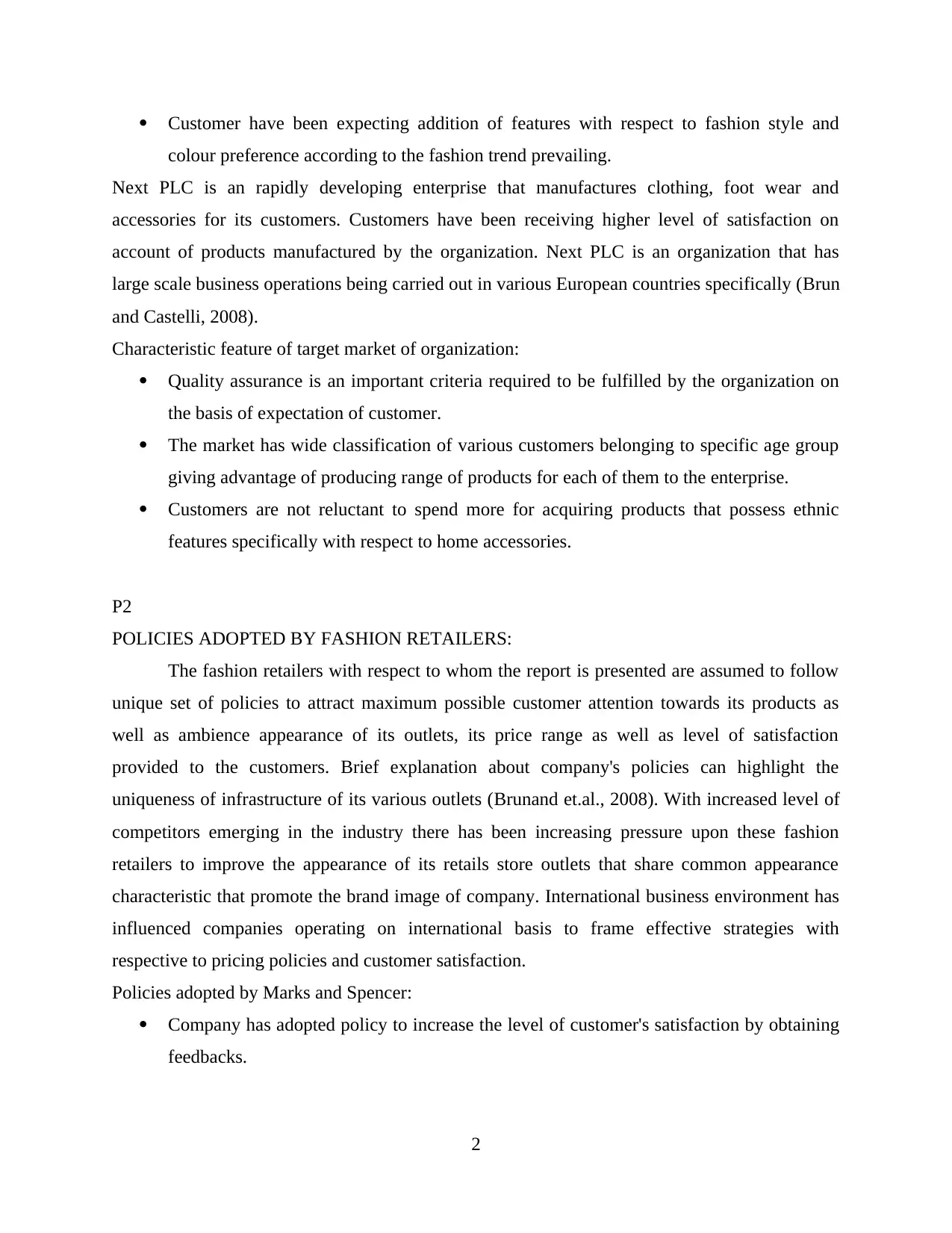
Customer have been expecting addition of features with respect to fashion style and
colour preference according to the fashion trend prevailing.
Next PLC is an rapidly developing enterprise that manufactures clothing, foot wear and
accessories for its customers. Customers have been receiving higher level of satisfaction on
account of products manufactured by the organization. Next PLC is an organization that has
large scale business operations being carried out in various European countries specifically (Brun
and Castelli, 2008).
Characteristic feature of target market of organization:
Quality assurance is an important criteria required to be fulfilled by the organization on
the basis of expectation of customer.
The market has wide classification of various customers belonging to specific age group
giving advantage of producing range of products for each of them to the enterprise.
Customers are not reluctant to spend more for acquiring products that possess ethnic
features specifically with respect to home accessories.
P2
POLICIES ADOPTED BY FASHION RETAILERS:
The fashion retailers with respect to whom the report is presented are assumed to follow
unique set of policies to attract maximum possible customer attention towards its products as
well as ambience appearance of its outlets, its price range as well as level of satisfaction
provided to the customers. Brief explanation about company's policies can highlight the
uniqueness of infrastructure of its various outlets (Brunand et.al., 2008). With increased level of
competitors emerging in the industry there has been increasing pressure upon these fashion
retailers to improve the appearance of its retails store outlets that share common appearance
characteristic that promote the brand image of company. International business environment has
influenced companies operating on international basis to frame effective strategies with
respective to pricing policies and customer satisfaction.
Policies adopted by Marks and Spencer:
Company has adopted policy to increase the level of customer's satisfaction by obtaining
feedbacks.
2
colour preference according to the fashion trend prevailing.
Next PLC is an rapidly developing enterprise that manufactures clothing, foot wear and
accessories for its customers. Customers have been receiving higher level of satisfaction on
account of products manufactured by the organization. Next PLC is an organization that has
large scale business operations being carried out in various European countries specifically (Brun
and Castelli, 2008).
Characteristic feature of target market of organization:
Quality assurance is an important criteria required to be fulfilled by the organization on
the basis of expectation of customer.
The market has wide classification of various customers belonging to specific age group
giving advantage of producing range of products for each of them to the enterprise.
Customers are not reluctant to spend more for acquiring products that possess ethnic
features specifically with respect to home accessories.
P2
POLICIES ADOPTED BY FASHION RETAILERS:
The fashion retailers with respect to whom the report is presented are assumed to follow
unique set of policies to attract maximum possible customer attention towards its products as
well as ambience appearance of its outlets, its price range as well as level of satisfaction
provided to the customers. Brief explanation about company's policies can highlight the
uniqueness of infrastructure of its various outlets (Brunand et.al., 2008). With increased level of
competitors emerging in the industry there has been increasing pressure upon these fashion
retailers to improve the appearance of its retails store outlets that share common appearance
characteristic that promote the brand image of company. International business environment has
influenced companies operating on international basis to frame effective strategies with
respective to pricing policies and customer satisfaction.
Policies adopted by Marks and Spencer:
Company has adopted policy to increase the level of customer's satisfaction by obtaining
feedbacks.
2
Paraphrase This Document
Need a fresh take? Get an instant paraphrase of this document with our AI Paraphraser
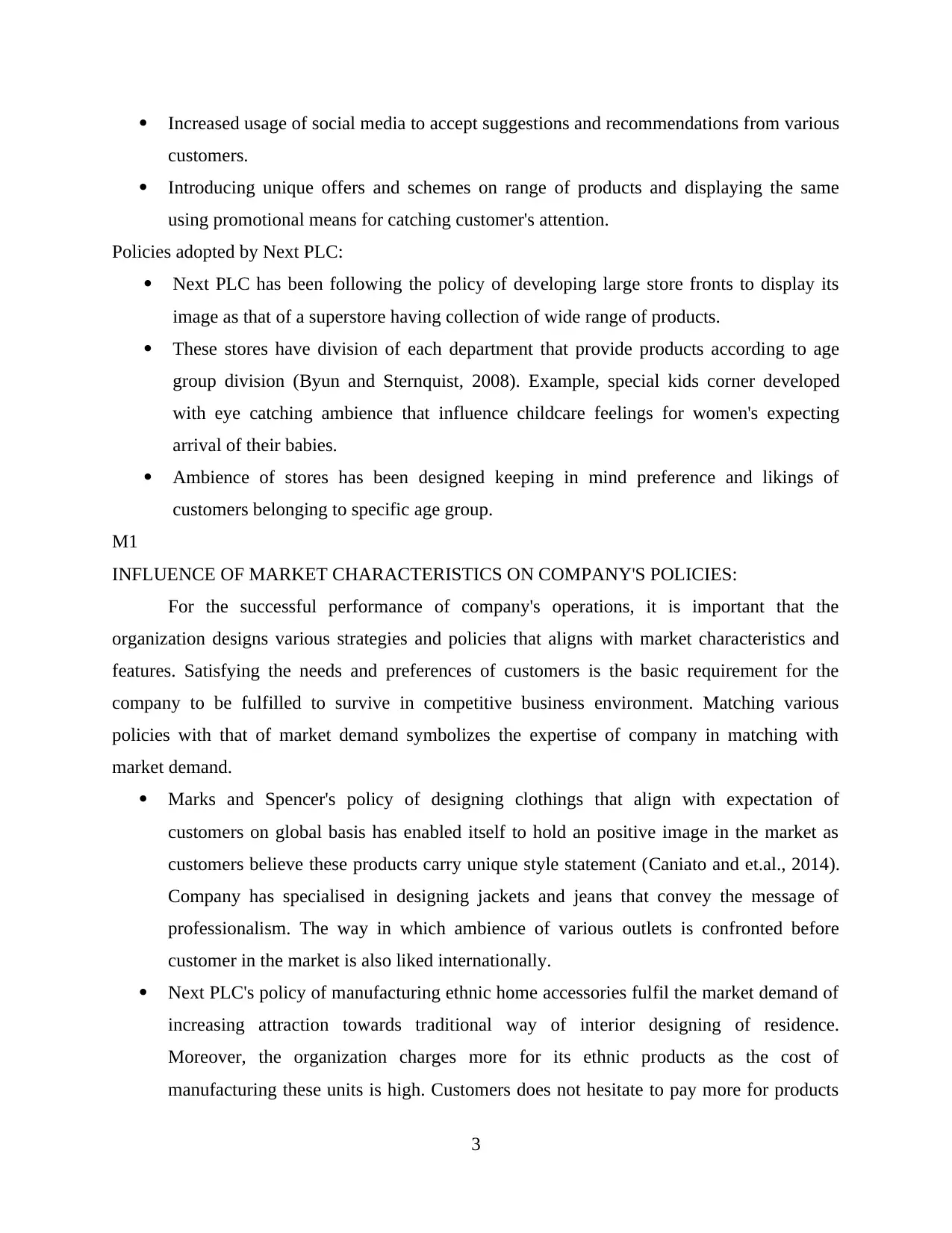
Increased usage of social media to accept suggestions and recommendations from various
customers.
Introducing unique offers and schemes on range of products and displaying the same
using promotional means for catching customer's attention.
Policies adopted by Next PLC:
Next PLC has been following the policy of developing large store fronts to display its
image as that of a superstore having collection of wide range of products.
These stores have division of each department that provide products according to age
group division (Byun and Sternquist, 2008). Example, special kids corner developed
with eye catching ambience that influence childcare feelings for women's expecting
arrival of their babies.
Ambience of stores has been designed keeping in mind preference and likings of
customers belonging to specific age group.
M1
INFLUENCE OF MARKET CHARACTERISTICS ON COMPANY'S POLICIES:
For the successful performance of company's operations, it is important that the
organization designs various strategies and policies that aligns with market characteristics and
features. Satisfying the needs and preferences of customers is the basic requirement for the
company to be fulfilled to survive in competitive business environment. Matching various
policies with that of market demand symbolizes the expertise of company in matching with
market demand.
Marks and Spencer's policy of designing clothings that align with expectation of
customers on global basis has enabled itself to hold an positive image in the market as
customers believe these products carry unique style statement (Caniato and et.al., 2014).
Company has specialised in designing jackets and jeans that convey the message of
professionalism. The way in which ambience of various outlets is confronted before
customer in the market is also liked internationally.
Next PLC's policy of manufacturing ethnic home accessories fulfil the market demand of
increasing attraction towards traditional way of interior designing of residence.
Moreover, the organization charges more for its ethnic products as the cost of
manufacturing these units is high. Customers does not hesitate to pay more for products
3
customers.
Introducing unique offers and schemes on range of products and displaying the same
using promotional means for catching customer's attention.
Policies adopted by Next PLC:
Next PLC has been following the policy of developing large store fronts to display its
image as that of a superstore having collection of wide range of products.
These stores have division of each department that provide products according to age
group division (Byun and Sternquist, 2008). Example, special kids corner developed
with eye catching ambience that influence childcare feelings for women's expecting
arrival of their babies.
Ambience of stores has been designed keeping in mind preference and likings of
customers belonging to specific age group.
M1
INFLUENCE OF MARKET CHARACTERISTICS ON COMPANY'S POLICIES:
For the successful performance of company's operations, it is important that the
organization designs various strategies and policies that aligns with market characteristics and
features. Satisfying the needs and preferences of customers is the basic requirement for the
company to be fulfilled to survive in competitive business environment. Matching various
policies with that of market demand symbolizes the expertise of company in matching with
market demand.
Marks and Spencer's policy of designing clothings that align with expectation of
customers on global basis has enabled itself to hold an positive image in the market as
customers believe these products carry unique style statement (Caniato and et.al., 2014).
Company has specialised in designing jackets and jeans that convey the message of
professionalism. The way in which ambience of various outlets is confronted before
customer in the market is also liked internationally.
Next PLC's policy of manufacturing ethnic home accessories fulfil the market demand of
increasing attraction towards traditional way of interior designing of residence.
Moreover, the organization charges more for its ethnic products as the cost of
manufacturing these units is high. Customers does not hesitate to pay more for products
3
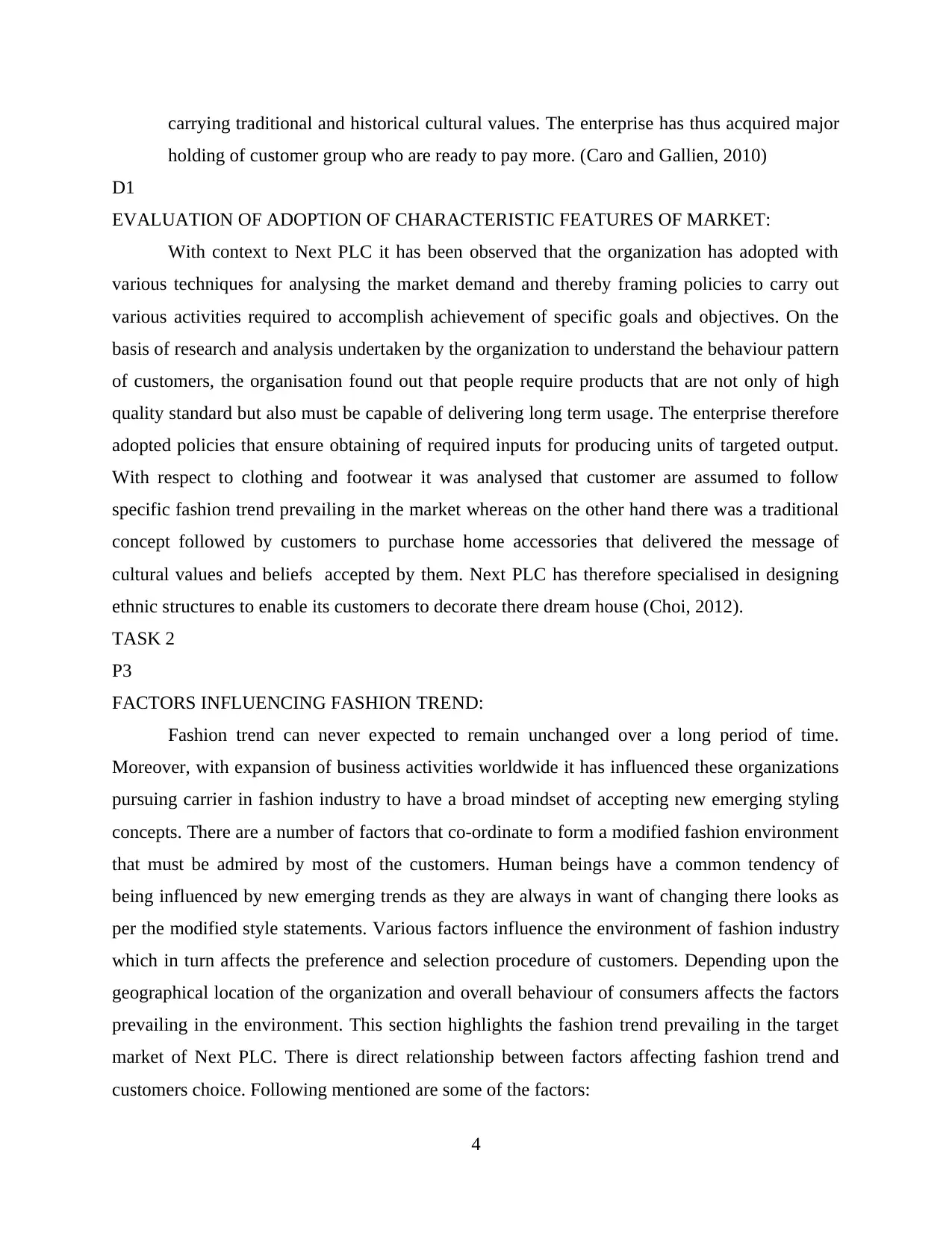
carrying traditional and historical cultural values. The enterprise has thus acquired major
holding of customer group who are ready to pay more. (Caro and Gallien, 2010)
D1
EVALUATION OF ADOPTION OF CHARACTERISTIC FEATURES OF MARKET:
With context to Next PLC it has been observed that the organization has adopted with
various techniques for analysing the market demand and thereby framing policies to carry out
various activities required to accomplish achievement of specific goals and objectives. On the
basis of research and analysis undertaken by the organization to understand the behaviour pattern
of customers, the organisation found out that people require products that are not only of high
quality standard but also must be capable of delivering long term usage. The enterprise therefore
adopted policies that ensure obtaining of required inputs for producing units of targeted output.
With respect to clothing and footwear it was analysed that customer are assumed to follow
specific fashion trend prevailing in the market whereas on the other hand there was a traditional
concept followed by customers to purchase home accessories that delivered the message of
cultural values and beliefs accepted by them. Next PLC has therefore specialised in designing
ethnic structures to enable its customers to decorate there dream house (Choi, 2012).
TASK 2
P3
FACTORS INFLUENCING FASHION TREND:
Fashion trend can never expected to remain unchanged over a long period of time.
Moreover, with expansion of business activities worldwide it has influenced these organizations
pursuing carrier in fashion industry to have a broad mindset of accepting new emerging styling
concepts. There are a number of factors that co-ordinate to form a modified fashion environment
that must be admired by most of the customers. Human beings have a common tendency of
being influenced by new emerging trends as they are always in want of changing there looks as
per the modified style statements. Various factors influence the environment of fashion industry
which in turn affects the preference and selection procedure of customers. Depending upon the
geographical location of the organization and overall behaviour of consumers affects the factors
prevailing in the environment. This section highlights the fashion trend prevailing in the target
market of Next PLC. There is direct relationship between factors affecting fashion trend and
customers choice. Following mentioned are some of the factors:
4
holding of customer group who are ready to pay more. (Caro and Gallien, 2010)
D1
EVALUATION OF ADOPTION OF CHARACTERISTIC FEATURES OF MARKET:
With context to Next PLC it has been observed that the organization has adopted with
various techniques for analysing the market demand and thereby framing policies to carry out
various activities required to accomplish achievement of specific goals and objectives. On the
basis of research and analysis undertaken by the organization to understand the behaviour pattern
of customers, the organisation found out that people require products that are not only of high
quality standard but also must be capable of delivering long term usage. The enterprise therefore
adopted policies that ensure obtaining of required inputs for producing units of targeted output.
With respect to clothing and footwear it was analysed that customer are assumed to follow
specific fashion trend prevailing in the market whereas on the other hand there was a traditional
concept followed by customers to purchase home accessories that delivered the message of
cultural values and beliefs accepted by them. Next PLC has therefore specialised in designing
ethnic structures to enable its customers to decorate there dream house (Choi, 2012).
TASK 2
P3
FACTORS INFLUENCING FASHION TREND:
Fashion trend can never expected to remain unchanged over a long period of time.
Moreover, with expansion of business activities worldwide it has influenced these organizations
pursuing carrier in fashion industry to have a broad mindset of accepting new emerging styling
concepts. There are a number of factors that co-ordinate to form a modified fashion environment
that must be admired by most of the customers. Human beings have a common tendency of
being influenced by new emerging trends as they are always in want of changing there looks as
per the modified style statements. Various factors influence the environment of fashion industry
which in turn affects the preference and selection procedure of customers. Depending upon the
geographical location of the organization and overall behaviour of consumers affects the factors
prevailing in the environment. This section highlights the fashion trend prevailing in the target
market of Next PLC. There is direct relationship between factors affecting fashion trend and
customers choice. Following mentioned are some of the factors:
4
⊘ This is a preview!⊘
Do you want full access?
Subscribe today to unlock all pages.

Trusted by 1+ million students worldwide

Celebrities: The fashion statement followed by male or female celebrities of respective
regional area influence mindset of majority of people (De Brito, Carbone and Blanquart,
2008). Every customer is assumed to have liking of style of clothing and appearance of
personality with respect to any of the celebrity. Customers are always observed to copy
the design of footwear or clothing adopted by their favourite film stars so as to build
influencing personality within the society to which they belong. There has been increased
liking for casual wear delivering comfort in carrying out with such outfits.
Media: It has been an important element of influencing wide range of people, Every
customer is attached with the media world to keep themselves in regular touch with the
changing trends and fashion statements. Customers are assumed to possess in depth
knowledge of market situation and conditions prevailing. People have a high level of trust
with media. They therefore are easily influenced by any information or detail released by
media. Media has been putting forward the fact that there has been increased sense of
liking for products that are eco-friendly. Another concept of increased liking for branded
products among customers have influenced themselves to purchase goods that hold
unique brand image such as those of Next PLC (Doherty, 2009).
Climate and Weather: It has been observed very often that women dress with accordance
to regional weather and climate. For example, with reference to market analysis the
organization manufactures long sleeved tops and dress during winter season as well as it
designs special range of products for summer collection too.
P4
TWO DIFFERENT FASHION TRENDS:
This section focuses to mention two different fashion trend prevailing in business
environment with context to Marks and Spencer and Next PLC. Marks and Spencer is an
company that is holding a major share in cosmetics department. It has a positive influence on
women section as it produces range of products that enables them to enhance their beauty. The
trend has been common among women with respect to use expensive range of cosmetics. More
demand for bright coloured lipsticks has influenced the company to manufacture the same as it
has been observed that company has major share of young women in its customer group who like
to spend a lot of there income after purchasing beauty products with an increased trend of
enhancing skin and radiance (Hines and Bruce, 2007). This has led the organization to allocate
5
regional area influence mindset of majority of people (De Brito, Carbone and Blanquart,
2008). Every customer is assumed to have liking of style of clothing and appearance of
personality with respect to any of the celebrity. Customers are always observed to copy
the design of footwear or clothing adopted by their favourite film stars so as to build
influencing personality within the society to which they belong. There has been increased
liking for casual wear delivering comfort in carrying out with such outfits.
Media: It has been an important element of influencing wide range of people, Every
customer is attached with the media world to keep themselves in regular touch with the
changing trends and fashion statements. Customers are assumed to possess in depth
knowledge of market situation and conditions prevailing. People have a high level of trust
with media. They therefore are easily influenced by any information or detail released by
media. Media has been putting forward the fact that there has been increased sense of
liking for products that are eco-friendly. Another concept of increased liking for branded
products among customers have influenced themselves to purchase goods that hold
unique brand image such as those of Next PLC (Doherty, 2009).
Climate and Weather: It has been observed very often that women dress with accordance
to regional weather and climate. For example, with reference to market analysis the
organization manufactures long sleeved tops and dress during winter season as well as it
designs special range of products for summer collection too.
P4
TWO DIFFERENT FASHION TRENDS:
This section focuses to mention two different fashion trend prevailing in business
environment with context to Marks and Spencer and Next PLC. Marks and Spencer is an
company that is holding a major share in cosmetics department. It has a positive influence on
women section as it produces range of products that enables them to enhance their beauty. The
trend has been common among women with respect to use expensive range of cosmetics. More
demand for bright coloured lipsticks has influenced the company to manufacture the same as it
has been observed that company has major share of young women in its customer group who like
to spend a lot of there income after purchasing beauty products with an increased trend of
enhancing skin and radiance (Hines and Bruce, 2007). This has led the organization to allocate
5
Paraphrase This Document
Need a fresh take? Get an instant paraphrase of this document with our AI Paraphraser
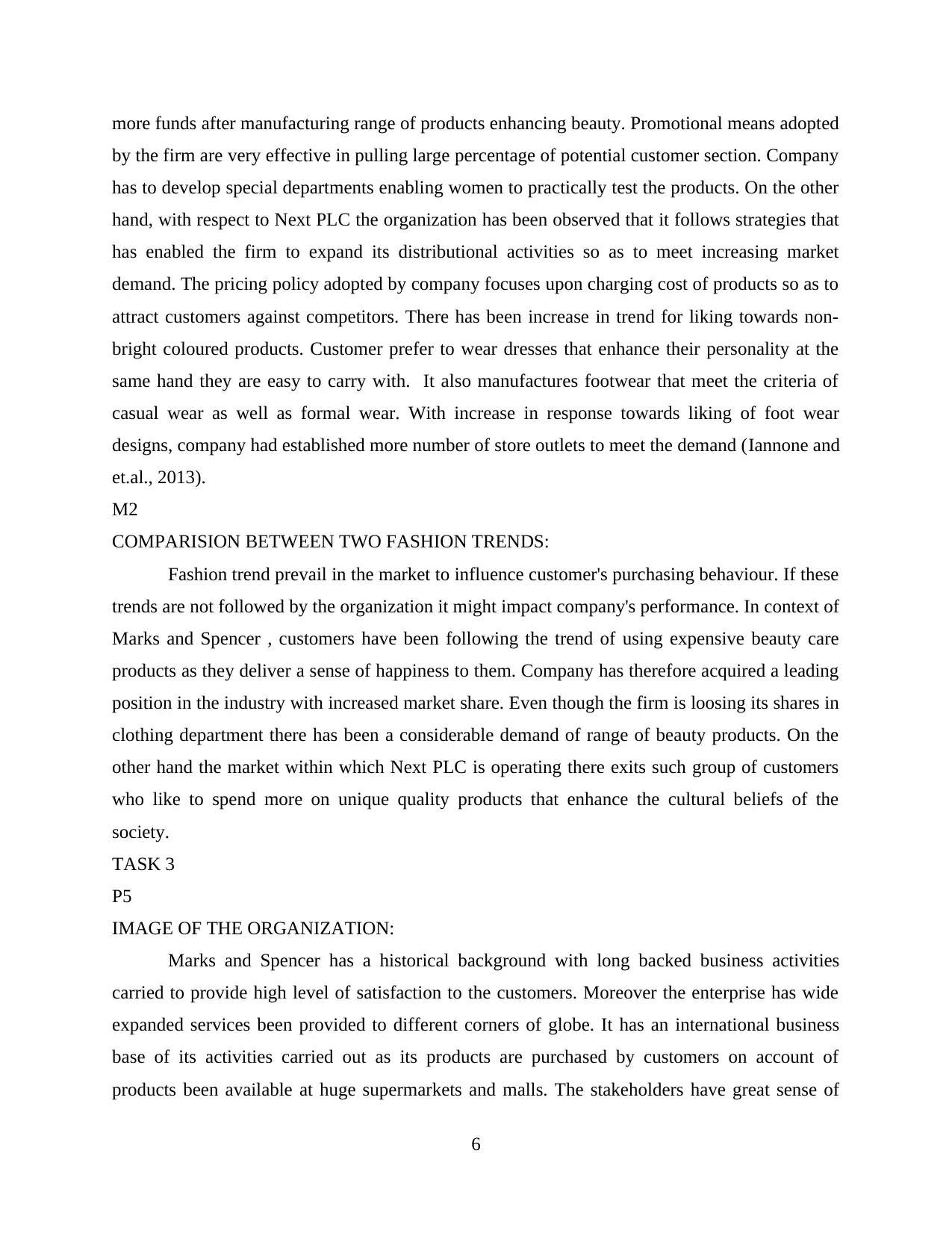
more funds after manufacturing range of products enhancing beauty. Promotional means adopted
by the firm are very effective in pulling large percentage of potential customer section. Company
has to develop special departments enabling women to practically test the products. On the other
hand, with respect to Next PLC the organization has been observed that it follows strategies that
has enabled the firm to expand its distributional activities so as to meet increasing market
demand. The pricing policy adopted by company focuses upon charging cost of products so as to
attract customers against competitors. There has been increase in trend for liking towards non-
bright coloured products. Customer prefer to wear dresses that enhance their personality at the
same hand they are easy to carry with. It also manufactures footwear that meet the criteria of
casual wear as well as formal wear. With increase in response towards liking of foot wear
designs, company had established more number of store outlets to meet the demand (Iannone and
et.al., 2013).
M2
COMPARISION BETWEEN TWO FASHION TRENDS:
Fashion trend prevail in the market to influence customer's purchasing behaviour. If these
trends are not followed by the organization it might impact company's performance. In context of
Marks and Spencer , customers have been following the trend of using expensive beauty care
products as they deliver a sense of happiness to them. Company has therefore acquired a leading
position in the industry with increased market share. Even though the firm is loosing its shares in
clothing department there has been a considerable demand of range of beauty products. On the
other hand the market within which Next PLC is operating there exits such group of customers
who like to spend more on unique quality products that enhance the cultural beliefs of the
society.
TASK 3
P5
IMAGE OF THE ORGANIZATION:
Marks and Spencer has a historical background with long backed business activities
carried to provide high level of satisfaction to the customers. Moreover the enterprise has wide
expanded services been provided to different corners of globe. It has an international business
base of its activities carried out as its products are purchased by customers on account of
products been available at huge supermarkets and malls. The stakeholders have great sense of
6
by the firm are very effective in pulling large percentage of potential customer section. Company
has to develop special departments enabling women to practically test the products. On the other
hand, with respect to Next PLC the organization has been observed that it follows strategies that
has enabled the firm to expand its distributional activities so as to meet increasing market
demand. The pricing policy adopted by company focuses upon charging cost of products so as to
attract customers against competitors. There has been increase in trend for liking towards non-
bright coloured products. Customer prefer to wear dresses that enhance their personality at the
same hand they are easy to carry with. It also manufactures footwear that meet the criteria of
casual wear as well as formal wear. With increase in response towards liking of foot wear
designs, company had established more number of store outlets to meet the demand (Iannone and
et.al., 2013).
M2
COMPARISION BETWEEN TWO FASHION TRENDS:
Fashion trend prevail in the market to influence customer's purchasing behaviour. If these
trends are not followed by the organization it might impact company's performance. In context of
Marks and Spencer , customers have been following the trend of using expensive beauty care
products as they deliver a sense of happiness to them. Company has therefore acquired a leading
position in the industry with increased market share. Even though the firm is loosing its shares in
clothing department there has been a considerable demand of range of beauty products. On the
other hand the market within which Next PLC is operating there exits such group of customers
who like to spend more on unique quality products that enhance the cultural beliefs of the
society.
TASK 3
P5
IMAGE OF THE ORGANIZATION:
Marks and Spencer has a historical background with long backed business activities
carried to provide high level of satisfaction to the customers. Moreover the enterprise has wide
expanded services been provided to different corners of globe. It has an international business
base of its activities carried out as its products are purchased by customers on account of
products been available at huge supermarkets and malls. The stakeholders have great sense of
6
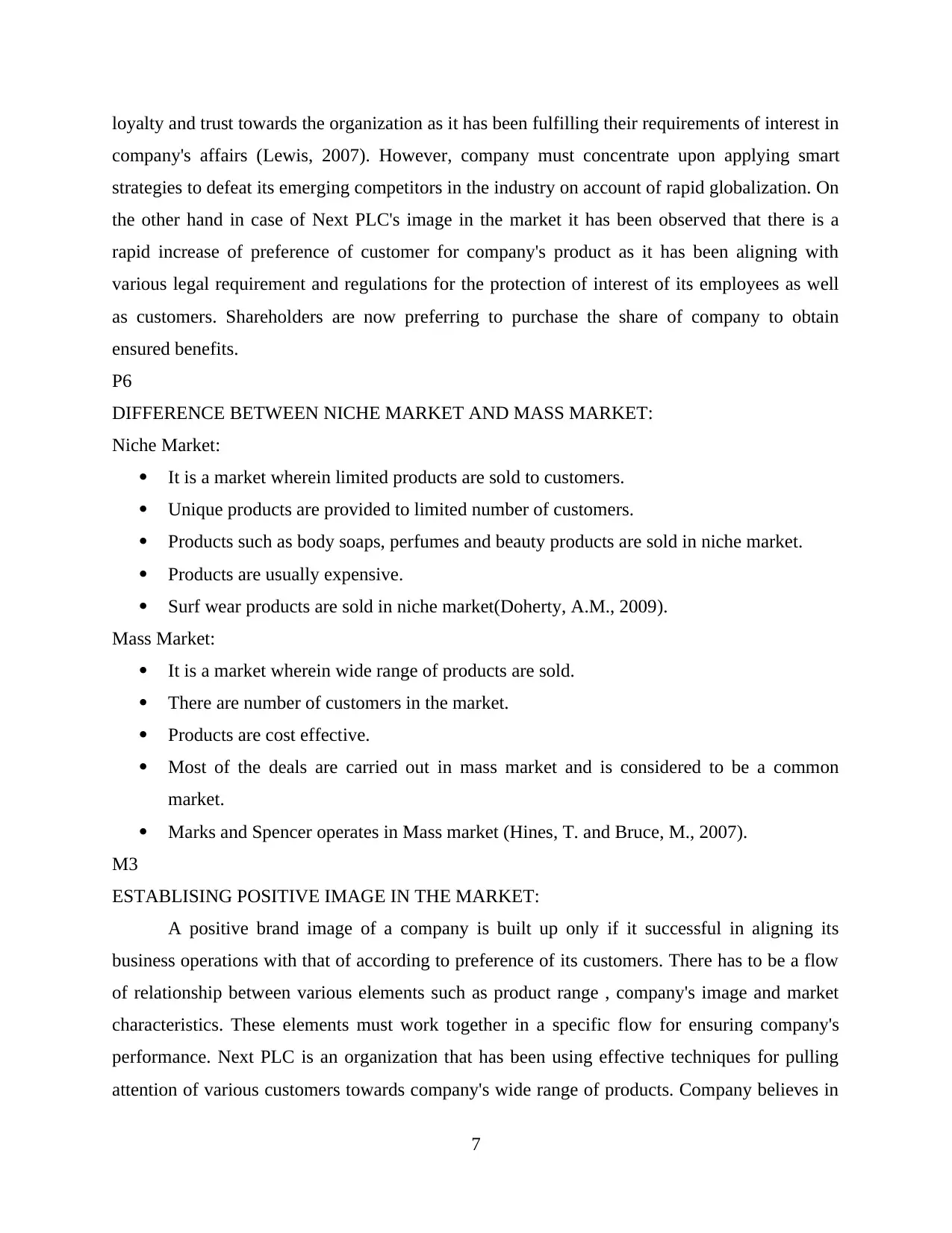
loyalty and trust towards the organization as it has been fulfilling their requirements of interest in
company's affairs (Lewis, 2007). However, company must concentrate upon applying smart
strategies to defeat its emerging competitors in the industry on account of rapid globalization. On
the other hand in case of Next PLC's image in the market it has been observed that there is a
rapid increase of preference of customer for company's product as it has been aligning with
various legal requirement and regulations for the protection of interest of its employees as well
as customers. Shareholders are now preferring to purchase the share of company to obtain
ensured benefits.
P6
DIFFERENCE BETWEEN NICHE MARKET AND MASS MARKET:
Niche Market:
It is a market wherein limited products are sold to customers.
Unique products are provided to limited number of customers.
Products such as body soaps, perfumes and beauty products are sold in niche market.
Products are usually expensive.
Surf wear products are sold in niche market(Doherty, A.M., 2009).
Mass Market:
It is a market wherein wide range of products are sold.
There are number of customers in the market.
Products are cost effective.
Most of the deals are carried out in mass market and is considered to be a common
market.
Marks and Spencer operates in Mass market (Hines, T. and Bruce, M., 2007).
M3
ESTABLISING POSITIVE IMAGE IN THE MARKET:
A positive brand image of a company is built up only if it successful in aligning its
business operations with that of according to preference of its customers. There has to be a flow
of relationship between various elements such as product range , company's image and market
characteristics. These elements must work together in a specific flow for ensuring company's
performance. Next PLC is an organization that has been using effective techniques for pulling
attention of various customers towards company's wide range of products. Company believes in
7
company's affairs (Lewis, 2007). However, company must concentrate upon applying smart
strategies to defeat its emerging competitors in the industry on account of rapid globalization. On
the other hand in case of Next PLC's image in the market it has been observed that there is a
rapid increase of preference of customer for company's product as it has been aligning with
various legal requirement and regulations for the protection of interest of its employees as well
as customers. Shareholders are now preferring to purchase the share of company to obtain
ensured benefits.
P6
DIFFERENCE BETWEEN NICHE MARKET AND MASS MARKET:
Niche Market:
It is a market wherein limited products are sold to customers.
Unique products are provided to limited number of customers.
Products such as body soaps, perfumes and beauty products are sold in niche market.
Products are usually expensive.
Surf wear products are sold in niche market(Doherty, A.M., 2009).
Mass Market:
It is a market wherein wide range of products are sold.
There are number of customers in the market.
Products are cost effective.
Most of the deals are carried out in mass market and is considered to be a common
market.
Marks and Spencer operates in Mass market (Hines, T. and Bruce, M., 2007).
M3
ESTABLISING POSITIVE IMAGE IN THE MARKET:
A positive brand image of a company is built up only if it successful in aligning its
business operations with that of according to preference of its customers. There has to be a flow
of relationship between various elements such as product range , company's image and market
characteristics. These elements must work together in a specific flow for ensuring company's
performance. Next PLC is an organization that has been using effective techniques for pulling
attention of various customers towards company's wide range of products. Company believes in
7
⊘ This is a preview!⊘
Do you want full access?
Subscribe today to unlock all pages.

Trusted by 1+ million students worldwide

designing products that possess all required characteristics admired by its customers including
those of potential customers too (Mathew, 2012). The enterprise has been exploiting the benefits
of globalization to expand its distributional activities wide over the globe. It has realized the
importance of contributing towards corporate social responsibility to confront the society with its
social services.
D2
WEAKNESSES OR GAPS:
Marks and Spencer has been facing the issue of decreasing market share in its clothing
section. The organization holds a strong historical background. However it has been unsuccessful
in exploiting the benefits of the same. Decreased investment of funds in promotional and
distributional activities is one of the reason behind company's decreasing level of performance.
Customers are more inclined to purchase products of other international business organizations.
It has not been successful in maintaining compatibility between its policies and customers
requirements (Miller and Moultrie, 2013). For bridging up this gap it is important that the
enterprise uses effective means of promoting its brand image by putting up efforts to frame
effective strategies to manufacture products with least cost to withstand among competitive
environment.
CONCLUSION
It can be concluded here that despite of sincere efforts been made by Marks and Spencer, the
organization has been losing its control upon holding of its wide target market. On the other hand
the activities of Next PLC has expanded worldwide at an increasing rate thereby achieving
tremendous success in the industry. The organization needs to put in a lot of efforts to be
compatible enough to align with market conditions. Company's performance and competence can
be measured by analysing how effectively the organization implements various policies and
strategies to accomplish its objectives as well as hold permanent position in the market by
building positive image within the society. Customer is the King of market and their
requirements must be the priority of company. It is thus important for the organisation to hold a
positive image in the market to ensure long term sustenance in the industry. If the organisation
does not maintain relationship with its customers it would surely endanger its very existence.
REFERENCES
Books and Journals
8
those of potential customers too (Mathew, 2012). The enterprise has been exploiting the benefits
of globalization to expand its distributional activities wide over the globe. It has realized the
importance of contributing towards corporate social responsibility to confront the society with its
social services.
D2
WEAKNESSES OR GAPS:
Marks and Spencer has been facing the issue of decreasing market share in its clothing
section. The organization holds a strong historical background. However it has been unsuccessful
in exploiting the benefits of the same. Decreased investment of funds in promotional and
distributional activities is one of the reason behind company's decreasing level of performance.
Customers are more inclined to purchase products of other international business organizations.
It has not been successful in maintaining compatibility between its policies and customers
requirements (Miller and Moultrie, 2013). For bridging up this gap it is important that the
enterprise uses effective means of promoting its brand image by putting up efforts to frame
effective strategies to manufacture products with least cost to withstand among competitive
environment.
CONCLUSION
It can be concluded here that despite of sincere efforts been made by Marks and Spencer, the
organization has been losing its control upon holding of its wide target market. On the other hand
the activities of Next PLC has expanded worldwide at an increasing rate thereby achieving
tremendous success in the industry. The organization needs to put in a lot of efforts to be
compatible enough to align with market conditions. Company's performance and competence can
be measured by analysing how effectively the organization implements various policies and
strategies to accomplish its objectives as well as hold permanent position in the market by
building positive image within the society. Customer is the King of market and their
requirements must be the priority of company. It is thus important for the organisation to hold a
positive image in the market to ensure long term sustenance in the industry. If the organisation
does not maintain relationship with its customers it would surely endanger its very existence.
REFERENCES
Books and Journals
8
Paraphrase This Document
Need a fresh take? Get an instant paraphrase of this document with our AI Paraphraser
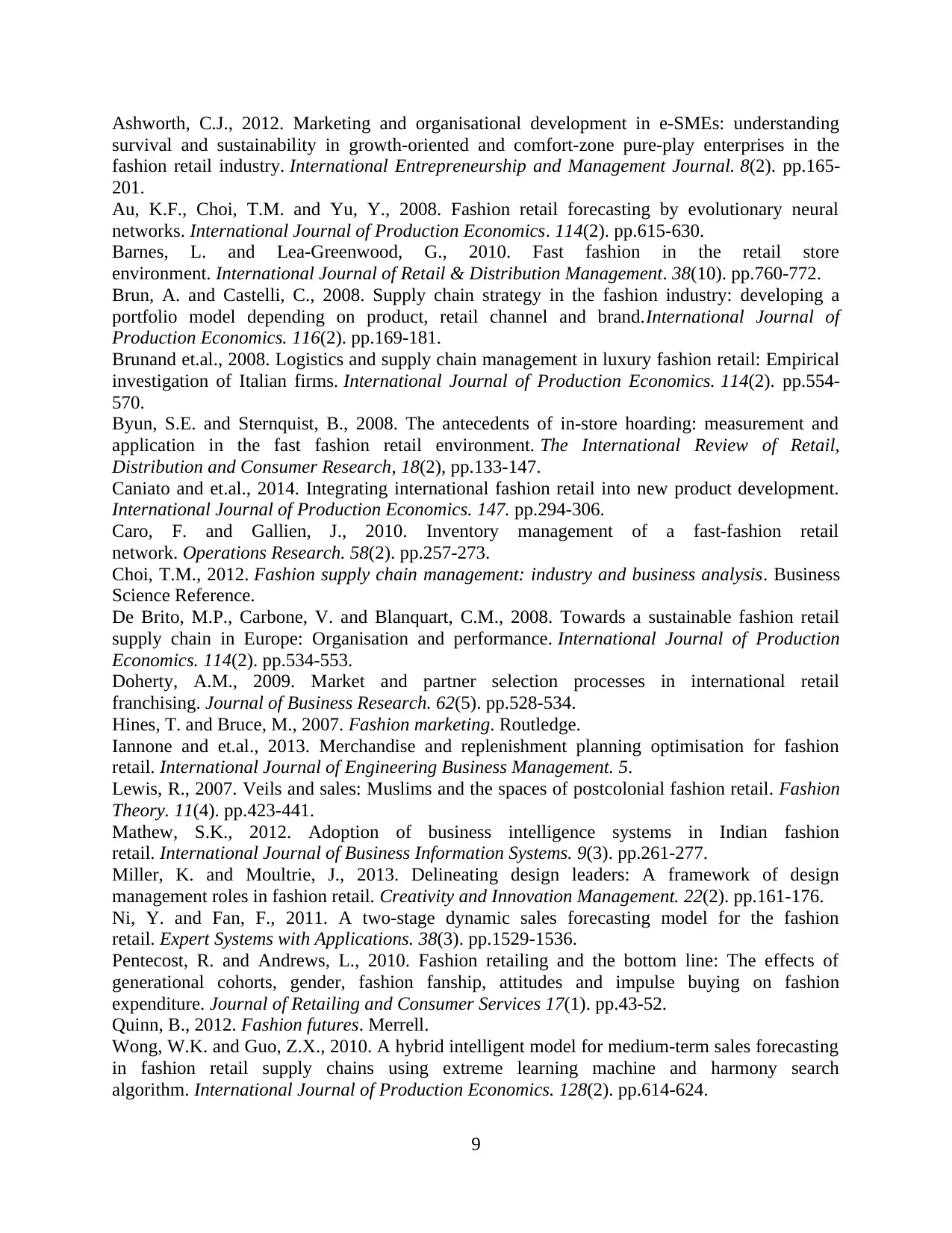
Ashworth, C.J., 2012. Marketing and organisational development in e-SMEs: understanding
survival and sustainability in growth-oriented and comfort-zone pure-play enterprises in the
fashion retail industry. International Entrepreneurship and Management Journal. 8(2). pp.165-
201.
Au, K.F., Choi, T.M. and Yu, Y., 2008. Fashion retail forecasting by evolutionary neural
networks. International Journal of Production Economics. 114(2). pp.615-630.
Barnes, L. and Lea-Greenwood, G., 2010. Fast fashion in the retail store
environment. International Journal of Retail & Distribution Management. 38(10). pp.760-772.
Brun, A. and Castelli, C., 2008. Supply chain strategy in the fashion industry: developing a
portfolio model depending on product, retail channel and brand.International Journal of
Production Economics. 116(2). pp.169-181.
Brunand et.al., 2008. Logistics and supply chain management in luxury fashion retail: Empirical
investigation of Italian firms. International Journal of Production Economics. 114(2). pp.554-
570.
Byun, S.E. and Sternquist, B., 2008. The antecedents of in-store hoarding: measurement and
application in the fast fashion retail environment. The International Review of Retail,
Distribution and Consumer Research, 18(2), pp.133-147.
Caniato and et.al., 2014. Integrating international fashion retail into new product development.
International Journal of Production Economics. 147. pp.294-306.
Caro, F. and Gallien, J., 2010. Inventory management of a fast-fashion retail
network. Operations Research. 58(2). pp.257-273.
Choi, T.M., 2012. Fashion supply chain management: industry and business analysis. Business
Science Reference.
De Brito, M.P., Carbone, V. and Blanquart, C.M., 2008. Towards a sustainable fashion retail
supply chain in Europe: Organisation and performance. International Journal of Production
Economics. 114(2). pp.534-553.
Doherty, A.M., 2009. Market and partner selection processes in international retail
franchising. Journal of Business Research. 62(5). pp.528-534.
Hines, T. and Bruce, M., 2007. Fashion marketing. Routledge.
Iannone and et.al., 2013. Merchandise and replenishment planning optimisation for fashion
retail. International Journal of Engineering Business Management. 5.
Lewis, R., 2007. Veils and sales: Muslims and the spaces of postcolonial fashion retail. Fashion
Theory. 11(4). pp.423-441.
Mathew, S.K., 2012. Adoption of business intelligence systems in Indian fashion
retail. International Journal of Business Information Systems. 9(3). pp.261-277.
Miller, K. and Moultrie, J., 2013. Delineating design leaders: A framework of design
management roles in fashion retail. Creativity and Innovation Management. 22(2). pp.161-176.
Ni, Y. and Fan, F., 2011. A two-stage dynamic sales forecasting model for the fashion
retail. Expert Systems with Applications. 38(3). pp.1529-1536.
Pentecost, R. and Andrews, L., 2010. Fashion retailing and the bottom line: The effects of
generational cohorts, gender, fashion fanship, attitudes and impulse buying on fashion
expenditure. Journal of Retailing and Consumer Services 17(1). pp.43-52.
Quinn, B., 2012. Fashion futures. Merrell.
Wong, W.K. and Guo, Z.X., 2010. A hybrid intelligent model for medium-term sales forecasting
in fashion retail supply chains using extreme learning machine and harmony search
algorithm. International Journal of Production Economics. 128(2). pp.614-624.
9
survival and sustainability in growth-oriented and comfort-zone pure-play enterprises in the
fashion retail industry. International Entrepreneurship and Management Journal. 8(2). pp.165-
201.
Au, K.F., Choi, T.M. and Yu, Y., 2008. Fashion retail forecasting by evolutionary neural
networks. International Journal of Production Economics. 114(2). pp.615-630.
Barnes, L. and Lea-Greenwood, G., 2010. Fast fashion in the retail store
environment. International Journal of Retail & Distribution Management. 38(10). pp.760-772.
Brun, A. and Castelli, C., 2008. Supply chain strategy in the fashion industry: developing a
portfolio model depending on product, retail channel and brand.International Journal of
Production Economics. 116(2). pp.169-181.
Brunand et.al., 2008. Logistics and supply chain management in luxury fashion retail: Empirical
investigation of Italian firms. International Journal of Production Economics. 114(2). pp.554-
570.
Byun, S.E. and Sternquist, B., 2008. The antecedents of in-store hoarding: measurement and
application in the fast fashion retail environment. The International Review of Retail,
Distribution and Consumer Research, 18(2), pp.133-147.
Caniato and et.al., 2014. Integrating international fashion retail into new product development.
International Journal of Production Economics. 147. pp.294-306.
Caro, F. and Gallien, J., 2010. Inventory management of a fast-fashion retail
network. Operations Research. 58(2). pp.257-273.
Choi, T.M., 2012. Fashion supply chain management: industry and business analysis. Business
Science Reference.
De Brito, M.P., Carbone, V. and Blanquart, C.M., 2008. Towards a sustainable fashion retail
supply chain in Europe: Organisation and performance. International Journal of Production
Economics. 114(2). pp.534-553.
Doherty, A.M., 2009. Market and partner selection processes in international retail
franchising. Journal of Business Research. 62(5). pp.528-534.
Hines, T. and Bruce, M., 2007. Fashion marketing. Routledge.
Iannone and et.al., 2013. Merchandise and replenishment planning optimisation for fashion
retail. International Journal of Engineering Business Management. 5.
Lewis, R., 2007. Veils and sales: Muslims and the spaces of postcolonial fashion retail. Fashion
Theory. 11(4). pp.423-441.
Mathew, S.K., 2012. Adoption of business intelligence systems in Indian fashion
retail. International Journal of Business Information Systems. 9(3). pp.261-277.
Miller, K. and Moultrie, J., 2013. Delineating design leaders: A framework of design
management roles in fashion retail. Creativity and Innovation Management. 22(2). pp.161-176.
Ni, Y. and Fan, F., 2011. A two-stage dynamic sales forecasting model for the fashion
retail. Expert Systems with Applications. 38(3). pp.1529-1536.
Pentecost, R. and Andrews, L., 2010. Fashion retailing and the bottom line: The effects of
generational cohorts, gender, fashion fanship, attitudes and impulse buying on fashion
expenditure. Journal of Retailing and Consumer Services 17(1). pp.43-52.
Quinn, B., 2012. Fashion futures. Merrell.
Wong, W.K. and Guo, Z.X., 2010. A hybrid intelligent model for medium-term sales forecasting
in fashion retail supply chains using extreme learning machine and harmony search
algorithm. International Journal of Production Economics. 128(2). pp.614-624.
9

Yu Sum, C. and Leung Hui, C., 2009. Salespersons' service quality and customer loyalty in
fashion chain stores: A study in Hong Kong retail stores. Journal of Fashion Marketing and
Management: An International Journal. 13(1). pp.98-108.
Online
Fashion Retail (3 Years) [Bsc]. 2013. [online]. Available
through<http://www.materials.manchester.ac.uk/study/undergraduate/undergraduate-courses/
textiles/fashion-retail-bsc/>. [Accessed on 24th December 2016].
Fashion Retailing and Merchandising. 2016. [online]. Available
through<http://education.lamar.edu/family-and-consumer-sciences/fashion-retailing-and-
merchandising/>. [Accessed on 24th December 2016].
Trends in International Fashion Retailing. 2016. [online]. Available
through<http://www.managementstudyguide.com/supply-chain-evolution-and-international-
retailing.htm>. [Accessed on 24th December 2016].
10
fashion chain stores: A study in Hong Kong retail stores. Journal of Fashion Marketing and
Management: An International Journal. 13(1). pp.98-108.
Online
Fashion Retail (3 Years) [Bsc]. 2013. [online]. Available
through<http://www.materials.manchester.ac.uk/study/undergraduate/undergraduate-courses/
textiles/fashion-retail-bsc/>. [Accessed on 24th December 2016].
Fashion Retailing and Merchandising. 2016. [online]. Available
through<http://education.lamar.edu/family-and-consumer-sciences/fashion-retailing-and-
merchandising/>. [Accessed on 24th December 2016].
Trends in International Fashion Retailing. 2016. [online]. Available
through<http://www.managementstudyguide.com/supply-chain-evolution-and-international-
retailing.htm>. [Accessed on 24th December 2016].
10
⊘ This is a preview!⊘
Do you want full access?
Subscribe today to unlock all pages.

Trusted by 1+ million students worldwide
1 out of 12
Related Documents
Your All-in-One AI-Powered Toolkit for Academic Success.
+13062052269
info@desklib.com
Available 24*7 on WhatsApp / Email
![[object Object]](/_next/static/media/star-bottom.7253800d.svg)
Unlock your academic potential
Copyright © 2020–2025 A2Z Services. All Rights Reserved. Developed and managed by ZUCOL.





